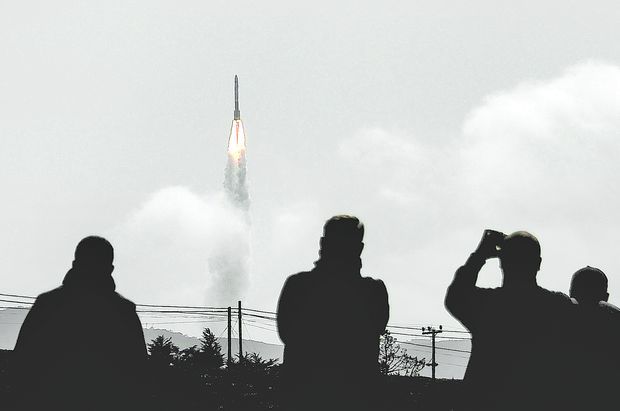$36 billion for national budget – from outer space
Ukrainian engineers expect to take part in NASA project building cargo ship to deliver goods to International Space Station
Ukraine is looking for strategic investors in its aerospace programs. The RNBO (National Security and Defense Council) has issued a resolution ordering all domestic military-industrial complex businesses to sever contacts with the Russian Federation in the military sphere. In other words, only projects relating to peaceful uses of outer space remain unaffected by sanctions.
Yurii Aleksieiev, head of the State Space Agency of Ukraine, says Ukraine has been making aerospace products for the Russian Federation worth some 150 million hryvnias annually, so there will be six-digit losses to be sustained.
Russia, however, stands to lose more, says Valentyn Badrak, director, Center for Army, Conversion and Disarmament Studies, adding that most such transactions were commercial projects for Ukraine, whereas Russia’s defense industry actually depended on them, so that the current situation spells imminent technological threats and challenges, including last but not least, Ukraine’s refusal to service Russia’s SS-18 Satan intercontinental ballistic missile: “Russians are putting on a cheerful front, but the situation is very bad; their military specialists can’t service this kind of missiles, so if they tried, they’d risk detonation at any moment.”
Badrak believes all military projects with Russia should be stopped and not renewed even after settling the armed conflict, so Ukraine must look for new markets and partners. He is confident that such markets and partners will be found, considering that Ukraine ranks fifth on the list of most developed countries in the aerospace industry – after the US, Russia, France, and China.
During various periods, according to experts, Ukraine received up to ten percent of the annual budget income from pre-launch contracts in the world’s aerospace industry. Conservative estimates point to $360 billion growth on this services market. In other words, Ukraine could annually receive 36 billion dollars – from outer space!
The United States is showing an interest in Ukraine’s aerospace industry. A delegation made up of officials of various US companies attended an international aerospace forum in Kyiv [September 25]. Ukraine is implementing a number of peaceful-uses-of-outer-space projects such as Sea Launch, Land Launch, building Zenit and Antares rockets, preparing Space Shuttle Mission STS-87 in collaboration with such noted US companies as Orbital Sciences, Boeing, and Honeywell Aerospace. Bernard Casey, president of the American Chamber of Commerce in Ukraine, said the US is planning Aerospace Valleys jointly with Ukraine, based in Dnipropetrovsk, Kharkiv, and Kyiv oblasts.
Oleksandr Dehtiariov, director general of the government-run Pivdenne Design Bureau, told The Day that the American side would be interested in Ukrainian aerospace engines, including landing modules: “Of course, we’d like to operate on this market – and we have the prerogatives.” He added that Project Maiak (it served as the basis for Antares) and Project Svitiaz (based on the Antonov [AN] model) could also prove of interest.
Says Serhii Voit, director general of the government-run Makarov Southern Machine-Building Works (Pivdenmash): “NASA is developing a cargo ship that will deliver goods to the International Space Station. We would like to take part in this project. Our aerospace facilities could be of use there; for all I know, they meet every NASA standard. We also have an experience of working with US technical documentation. This would spell jobs and contracts worth millions of dollars for the Pivdenne and Pivdenmash design bureaus. We’ve forwarded relevant messages to the US government and we know they are working on them.” He is sure Ukraine could offer the States certain space engine units and hull components: “We can make these components and they will match every US counterpart in terms of quality. We are already involved in the Antares construction project. Also, there is the SpaceX rocket. It is less expensive, but we could come up with an even less expensive design. All we need is time – three to five years.”
Ukraine is also moving in the European direction, albeit on a smaller scale compared to the American one. Here the emphasis is on the supplying of stages for the Vega rocket.
Serhii Voit: “We simply couldn’t move in the European direction at the pace we needed because all our cooperation was aimed at Russia. Adjusting to the European standards will be very difficult and expensive. Let me explain: when building a spaceship or rocket, it is necessary to run tests. We would take parts of a system from Russia and had no right to take such parts anywhere else. If and when we adopt the European standards, we’ll have to run a series of entirely new tests. This will cost mind-boggling sums.”
Valentyn Badrak: “Ukrainian [aerospace] businesses will have to make up for losses resulting from the severance of relationships with Russia by getting involved in large US and European projects. We have the intellectual and technological potential, considering that 12 out of [Russia’s] 20 most formidable ballistic missiles were manufactured in Dnipropetrovsk. This school of manufacture is still there and we keep the potential… It’s better to get 10 percent of an international project than sit on our hands, with the blueprints of our engineering solutions collecting dust on the shelves.” He is sure that Ukraine should be concerned about brain drain rather than about having new partners: “We must not let Russia buy Ukrainian rocket scientists and have them develop a new heavy-duty rocket or missile (the subject was actively discussed under President Yanukovych). This is precisely what the Ukrainian government, secret police, and counterintelligence service should have on top of their agenda.”
EXCLUSIVE
Bernard Casey, president of the American Chamber of Commerce in Ukraine, told The Day about the details of cooperation in the field of space exploration:
 “I mentioned one that recently happened with Toucan Engineering opening a facility here a month ago, employed about 50 Ukrainian engineers, and they designed fuselages and wings from some companies in the West. I have two other deals I know that are in process, one from an American company, and another one from a company in the UK. I don’t have liberty to speak about it currently, but one is a research and development center, and another one is actually a joint venture with an aerospace company.
“I mentioned one that recently happened with Toucan Engineering opening a facility here a month ago, employed about 50 Ukrainian engineers, and they designed fuselages and wings from some companies in the West. I have two other deals I know that are in process, one from an American company, and another one from a company in the UK. I don’t have liberty to speak about it currently, but one is a research and development center, and another one is actually a joint venture with an aerospace company.
“So, that is basically three different categories: one just located an office here, hiring engineers and doing some contract-designed services; the second, more complicated, would be joint ventures: one foreign company and one Ukrainian company coming together and work on some projects together; and then the most complicated would be a Western company taking over a Ukrainian company on concessions arrangement, like that may be possible with Antonov, or even privatization of some of these state-owned enterprises that are not profitable. It is not just American, it is going to be Canadian, it is going to be coming from the UK. We had people here today from Switzerland, from Central and Eastern Europe, so there will be a lot of investment coming.”
What amount on investment can go into Ukrainian economy for aerospace development in the nearest years?
“If you look at aircraft, the potential market for sales of aircraft is about 250 billion dollars a year. And then the market for space products and services is about 300 to 400 billion dollars a year. As for the investment that this year could sustain and develop, I would say we are looking probably at 5 to 10 billion dollars per year potential.”
Are there any specific projects in area of aerospace cooperation?
“The projects that already exist in cooperation with the Ukrainian aerospace industry are largely overseas. For instance, in NASA, the State Space Agency of the United States, they use some Ukrainian technology, and the Sea Launch, and the Antares, and a number of other rockets and missile systems. But I wanted something to benefit Ukrainians much more. So, investment here, creation of high-paying jobs for Ukrainians here, creation of the higher revenue here for the Ukrainian companies and higher tax revenues for the state – that’s my goal.”
Have the participants of this conference been interested in the proposals of the chairman of the Dnipropetrovsk regional council Yevhen Udod regarding aerospace technopark?
“This was his taking our initial idea, he mentioned, and developing a little bit further. Our idea was for an aerospace valley, much larger territory from Kyiv, to Kharkiv, to Dnipropetrovsk, that whole area including aircraft, missiles, rockets, satellites, satellite launching, also maybe commercial cosmonautics throughout that entire area. But it was not really a vision of technopark, we envisioned more like a Silicon Valley, where you basically had a whole high-tech ecosystem. Mr. Udod today presented this proposal for the first time of a technopark specifically in Dnipropetrovsk region. That’s fine, we support that, but that’s part of the overall bigger picture that includes again Kyiv and Kharkiv. We had speakers today from these cities.”
Do you know if American companies are interested in investing in such projects?
“Yes, some are in the works, but it is not for me to announce. First quarter of the next year, there will be some announcements.”
Can you make estimation on the size of budget involved?
“At this initial stage we are talking about millions of dollars, but not billions.”






